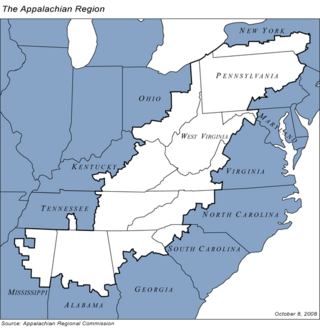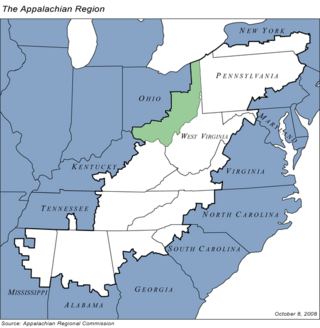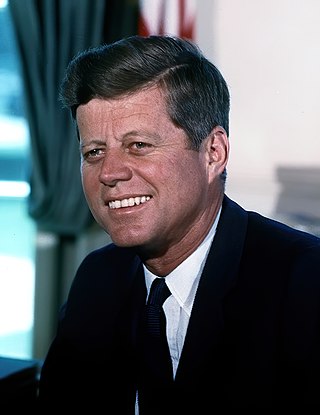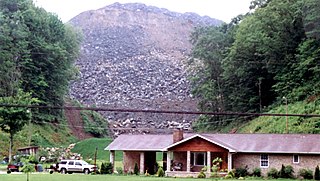Related Research Articles

The Second Bank of the United States was the second federally authorized Hamiltonian national bank in the United States. Located in Philadelphia, Pennsylvania, the bank was chartered from February 1816 to January 1836. The bank's formal name, according to section 9 of its charter as passed by Congress, was "The President Directors and Company of the Bank of the United States". While other banks in the US were chartered by and only allowed to have branches in a single state, it was authorized to have branches in multiple states and lend money to the US government.

The Great Society was a set of domestic programs in the United States launched by President Lyndon B. Johnson in 1964 and 1965. The term was first referenced during a 1964 speech by Johnson at Ohio University, then later formally presented at the University of Michigan, and came to represent his domestic agenda. The main goal was the total elimination of poverty and racial injustice.

Appalachia is a cultural region located in the central and southern sections of the Appalachian Mountains of the Eastern United States. It stretches from the western Catskill Mountains in the east end of the Southern Tier of New York State west and south into Pennsylvania, continuing on through the Blue Ridge Mountains into northern Georgia, and through the Great Smoky Mountains from North Carolina into Tennessee and northern Alabama. In 2020, the region was home to an estimated 26.1 million people, of whom roughly 80% are white.
The term New Frontier was used by Democratic presidential candidate John F. Kennedy in his acceptance speech in the 1960 United States presidential election to the Democratic National Convention at the Los Angeles Memorial Coliseum as the Democratic slogan to inspire America to support him. The phrase developed into a label for his administration's domestic and foreign programs.

The Appalachian Regional Commission (ARC) is a United States federal–state partnership that works with the people of Appalachia to create opportunities for self-sustaining economic development and improved quality of life. Congress established ARC to bring the region into socioeconomic parity with the rest of the nation.
Harry Monroe Caudill was an American author, historian, lawyer, legislator, and environmentalist from Letcher County, in the coalfields of southeastern Kentucky.
The Second New Deal is a term used by historians to characterize the second stage, 1935–36, of the New Deal programs of President Franklin D. Roosevelt. The most famous laws included the Emergency Relief Appropriation Act, the Banking Act, the Wagner National Labor Relations Act, the Public Utility Holding Companies Act, the Social Security Act, and the Wealth Tax Act.

Appalachian Ohio is a bioregion and political unit in the southeastern part of the U.S. state of Ohio, characterized by the western foothills of the Appalachian Mountains and the Appalachian Plateau. The Appalachian Regional Commission defines the region as consisting of thirty-two counties. This region roughly overlaps with the Appalachian mixed-mesophytic forests, which begin in southeast Ohio and southwest Pennsylvania and continue south to Georgia and Alabama. The mixed-mesophytic forest is found only in Central and Southern Appalachia and eastern/central China. It is one of the most biodiverse temperate forests in the world.

In the United States, the Hillbilly Highway is the out-migration of Appalachians from the Appalachian Highlands region to industrial cities in northern, midwestern, and western states, primarily in the years following World War II in search of better-paying industrial jobs and higher standards of living. Many of these migrants were formerly employed in the coal mining industry, which started to decline in 1940s. The word hillbilly refers to a negative stereotype of people from Appalachia. The term hillbilly is considered to be a modern term because it showed up in the early 1900s. Though the word is Scottish in origin, but doesn't derive from dialect. In Scotland, the term "hill-folk" referred to people who preferred isolation from the greater society and the term "billy" referred to someone being a "companion" or "comrade". The Hillbilly Highway was a parallel to the better-known Great Migration of African-Americans from the south.

John F. Kennedy's tenure as the 35th president of the United States, began with his inauguration on January 20, 1961, and ended with his assassination on November 22, 1963. A Democrat from Massachusetts, he took office following the 1960 presidential election, in which he narrowly defeated Richard Nixon, the then-incumbent vice president. He was succeeded by Vice President Lyndon B. Johnson.

Appalachia is a region of the Eastern United States. Home to over 25 million people, the region includes mountainous areas of 13 states: Mississippi, Alabama, Pennsylvania, New York, Georgia, South Carolina, North Carolina, Tennessee, Virginia, Kentucky, Ohio, Maryland, as well as the entirety of West Virginia.

The Council of the Southern Mountains (CSM) was a non-profit organization, active from 1912 to 1989, concerned with education and community development in southern Appalachia.

Appalachian Volunteers (AV) was a non-profit organization engaged in community development projects in central Appalachia that evolved into a controversial community organizing network, with a reputation that went "from self-help to sedition" as its staff developed from "reformers to radicals," teaching things from Marx, Lenin and Mao, in the words of one historian, in the brief period between 1964 and 1970 during the War on Poverty.
David Walls is an activist and academic who has made significant contributions to Appalachian studies and to the popular understanding of social movements. He is professor emeritus of sociology at Sonoma State University (SSU) in California, where he was dean of extended education from 1984 to 2000.

The New Deal was a series of programs, public work projects, financial reforms, and regulations enacted by President Franklin D. Roosevelt in the United States between 1933 and 1939. Major federal programs and agencies included the Civilian Conservation Corps (CCC), the Works Progress Administration (WPA), the Civil Works Administration (CWA), the Farm Security Administration (FSA), the National Industrial Recovery Act of 1933 (NIRA) and the Social Security Administration (SSA). They provided support for farmers, the unemployed, youth, and the elderly. The New Deal included new constraints and safeguards on the banking industry and efforts to re-inflate the economy after prices had fallen sharply. New Deal programs included both laws passed by Congress as well as presidential executive orders during the first term of the presidency of Franklin D. Roosevelt.

The Reagan era or Age of Reagan is a periodization of recent American history used by historians and political observers to emphasize that the conservative "Reagan Revolution" led by President Ronald Reagan in domestic and foreign policy had a lasting impact. It overlaps with what political scientists call the Sixth Party System. Definitions of the Reagan era universally include the 1980s, while more extensive definitions may also include the late 1970s, the 1990s, the 2000s, the 2010s, and even the 2020s. In his 2008 book, The Age of Reagan: A History, 1974–2008, historian and journalist Sean Wilentz argues that Reagan dominated this stretch of American history in the same way that Franklin D. Roosevelt and his New Deal legacy dominated the four decades that preceded it.

The Appalachian region and its people have historically been stereotyped by observers, with the basic perceptions of Appalachians painting them as backwards, rural, and anti-progressive. These widespread, limiting views of Appalachia and its people began to develop in the post-Civil War; Those who "discovered" Appalachia found it to be a very strange environment, and depicted its "otherness" in their writing. These depictions have persisted and are still present in common understandings of Appalachia today, with a particular increase of stereotypical imagery during the late 1950s and early 1960s in sitcoms. Common Appalachian stereotypes include those concerning economics, appearance, and the caricature of the "hillbilly."
The Appalachian Regional Development Act of 1965 established the Appalachian Regional Commission (ARC), which was tasked with overseeing economic development programs in the Appalachia region, as well as the construction of the Appalachian Development Highway System. Membership included representatives from New York, Pennsylvania, Ohio, Maryland, West Virginia, Virginia, Kentucky, Tennessee, North Carolina, South Carolina, Georgia, Alabama, and Mississippi, as well as one federal appointee. This Act is one of the longest serving place-based regional development programs in the United States, and is the largest in terms of geographic scope.

Environmental justice and coal mining in Appalachia is the study of environmental justice – the interdisciplinary body of social science literature studying theories of the environment and justice; environmental laws, policies, and their implementations and enforcement; development and sustainability; and political ecology – in relation to coal mining in Appalachia.
The Roving Picket Movement was the culmination of years of unrest from mine workers about their working conditions in Appalachia, a region of the United States. The movement lasted from 1959 to 1965, with goals of reinstating health benefits and improving working conditions. Miners protested at several mines in eastern Kentucky, and laid and the foundation for future movements within the Appalachian coal community.
References
- Ashley, Jeffrey S.; Jarmer, Marla J., eds. (2015). The Bully Pulpit, Presidential Speeches, and the Shaping of Public Policy. Lexington Books. ISBN 9781498501965.
- Brinkley, A.; Schlesinger, A.M.; Wilentz, S. (2012). John F. Kennedy: The American Presidents Series: The 35th President, 1961-1963. The American Presidents. Henry Holt and Company. ISBN 978-1-4299-7422-6.
- Cohen, Andrew (2016) [2014]. Two Days in June: John F. Kennedy and the 48 Hours That Changed History (illustrated, reprint ed.). McClelland & Stewart. ISBN 9780771023897.
- Duncan, J.K. (2013). John F. Kennedy: The Spirit of Cold War Liberalism. Routledge Historical Americans. Taylor & Francis. ISBN 978-1-136-17488-9.
- Giglio, J.N. (2006) [1991]. The Presidency of John F. Kennedy. American presidency series. University Press of Kansas. ISBN 978-0-7006-1457-8.
- Gillette, M.L. (2010). Launching the War on Poverty: An Oral History. Oxford Oral History Series. Oxford University Press. ISBN 978-0-19-977986-4.
- Reeves, Richard (1993). President Kennedy: Profile of Power . New York: Simon & Schuster. ISBN 978-0-671-64879-4.
- Risen, Clay (2014). The Bill of the Century: The Epic Battle for the Civil Rights Act (illustrated ed.). Bloomsbury Publishing USA. ISBN 9781608198245.
- Roth, Dennis (2002). "The Johnson Administration and the Great Society". In Roth, Dennis; Effland, Anne B. W.; Bowers, Douglas E. (eds.). Federal Rural Development Policy in the Twentieth Century. United States Department of Agriculture. Archived from the original (PDF) on 2005-10-24.
- Savage, Sean J. (2012). JFK, LBJ, and the Democratic Party. SUNY Press. ISBN 9780791484685.
- Shogan, Colleen J. (2007). The Moral Rhetoric of American Presidents (revised ed.). Texas A&M University Press. ISBN 9781585446391.